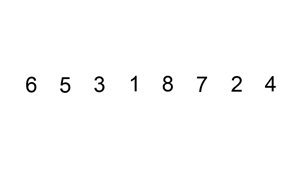Sort a linked list using insertion sort.

A graphical example of insertion sort. The partial sorted list (black) initially contains only the first element in the list.
With each iteration one element (red) is removed from the input data and inserted in-place into the sorted list
Algorithm of Insertion Sort:
- Insertion sort iterates, consuming one input element each repetition, and growing a sorted output list.
- At each iteration, insertion sort removes one element from the input data, finds the location it belongs within the sorted list, and inserts it there.
- It repeats until no input elements remain.
Example 1:
Input: 4->2->1->3 Output: 1->2->3->4
Example 2:
Input: -1->5->3->4->0 Output: -1->0->3->4->5
以下为评论区中的一种空间复杂度为O(1)的解法:
/**
* Definition for singly-linked list.
* public class ListNode {
* int val;
* ListNode next;
* ListNode(int x) { val = x; }
* }
*/
class Solution {
public ListNode insertionSortList(ListNode head) {
if( head == null ){
return head;
}
ListNode helper = new ListNode(0); //新的链表的表头
ListNode cur = head; //需要插入的节点
ListNode pre = helper; //节点插入的位置在pre与pre.next之间
ListNode next = null; //下一个需要插入的节点
while ( cur != null )
{
next = cur.next;
//找到需要插入的节点的位置
while ( pre.next != null && pre.next.val < cur.val)
pre = pre.next;
//插入节点
cur.next = pre.next;
pre.next = cur;
pre = helper;
cur = next;
}
return helper.next;
}
}








 本文详细介绍了使用插入排序算法对链表进行排序的过程。通过迭代输入元素并逐步构建已排序的输出列表,每次迭代移除一个元素,找到其在已排序列表中的正确位置并插入。文章提供了具体实例,如4->2->1->3排序后变为1->2->3->4,以及-1->5->3->4->0排序后变为-1->0->3->4->5。同时,附带了一种空间复杂度为O(1)的解决方案。
本文详细介绍了使用插入排序算法对链表进行排序的过程。通过迭代输入元素并逐步构建已排序的输出列表,每次迭代移除一个元素,找到其在已排序列表中的正确位置并插入。文章提供了具体实例,如4->2->1->3排序后变为1->2->3->4,以及-1->5->3->4->0排序后变为-1->0->3->4->5。同时,附带了一种空间复杂度为O(1)的解决方案。
















 1709
1709

 被折叠的 条评论
为什么被折叠?
被折叠的 条评论
为什么被折叠?








